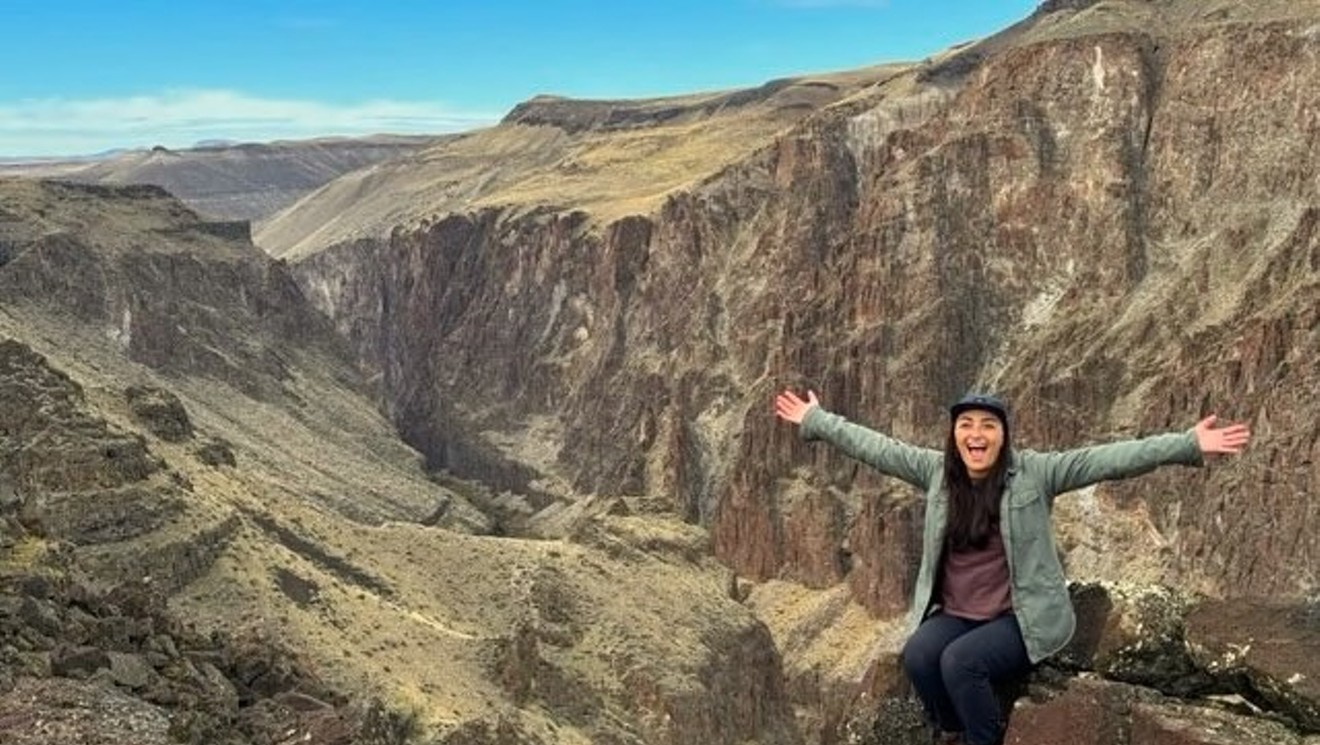The 45-acre park, which spans the Deschutes River at the Northwest end of town, was on the short list of parks up for consideration for Bend's next off-leash dog area. The other options included High Desert Park and the soon-to-be completed Pine Nursery Park, both of which are on Bend's eastside. Currently, park district staff has recommended to the parks board that the field at Sawyer be considered as the site of the new off-leash area, according to Director of Park Services Ed Moore.
The decision isn't final, and there is still a public meeting at the end of this month to further discuss the issue, but the possibility of losing the field where David Caplan and his fellow Bend Ultimate players have been hucking the disc since the club's inception in 1992, isn't sitting well with the members of the organization. The club currently uses the field for pick-up games on Tuesday and Thursday nights, despite the fact that the parks district doesn't officially consider the expansive stretch of well-manicured grass a sports field. In fact, in an e-mail to concerned ultimate players, the district said it was not aware that ultimate players were still using Sawyer Park. The field is also home to kickball games (most notably the tournament between rival Bend breweries) and other activities.
Caplan, although not a dog owner, isn't quite sure why Sawyer's field should be converted into an off-leash area.
"It seems like there's not a big urban need for it. Even if there is, which not being a dog owner I can't say for sure, I don't understand why a grassy field needs to be included in that," Caplan says.
Off-leash dog parks got their start in urban areas where there is little or no space to let a dog run off leash. While Bend is hardly a big city, some dog owners say that the demand for off-leash areas in Bend suggests that we're living in an increasingly urban (and suburban) style community.
Currently, dogs must be on the leash at Sawyer.In Portland, the city's parks and recreation department began exploring the need for off-leash areas about a decade ago and by 2000 began creating spots of dogs to run free. Today, the district has 31 areas, six of which are fenced, but some of those 31 parks only allow dogs to be off leash during certain hours, according to Marissa Dorias, a botanic technician who heads up Portland Parks and Recreation's Dogs for the Environment program.
"We have more of these parks per capita than most cities, and for the most part, the response from the public is positive," Dorias said.
In Bend, however, sanctioned off-leash areas are much newer to the landscape. Bend Metro Parks and Recreation District opened its first, and currently only, off-leash area in 2005 at Big Sky Park on the east side of town. The dog area includes three acres of fenced grass, which is a small chunk of the 97.2 acres that comprise Big Sky Park as a whole. There is another privately owned dog park in the Old Mill District that's open to the public, but it's not affiliated with BMPRD. Dogs are also allowed off the leash on the portions of the Deschutes River Trail maintained by the U.S. Forest Service, but not between May 1 and October 1.
But dog owners like Kreg Lindberg, a member of DogPAC, a group that originally worked with former police Chief Andy Jordan on the off-leash issue, believe that one official off-leash area is hardly enough for a dog-centric spot like Bend.
"We need to have convenient places where people can take their dogs off leash. If those places aren't convenient, then people will continue to go to whatever park is closest to them and basically break the law and have the dog off leash," said Lindberg, an instructor of recreation and tourism at OSU-Cascades.
Lindberg says he obeys leash laws when out with Lani, the mixed Labrador retriever he adopted a few years ago, but can't say the same for others. He sees this willingness by some to break a law that's accompanied by a relatively hefty fine as a testament to the need for off-leash areas.
"The fact that people are willing to risk a fine shows that they really value the off-leash experience," Lindberg said.
There is also an aesthetic question at stake with Sawyer Park. The field, or "meadow," as the parks district has referred to the location in recent e-mails to concerned ultimate players, despite the fact (which the players have pointed out) that the grass is mowed and irrigated (the word "meadow" technically refers to an un-maintained area of grass, or a field harvested for hay), is currently unrestricted by fences, bordered only by trees. That would change if the parks board designates the park as an off-leash area and a fence is built to enclose sections of the field.
"It really is a treasure and the fact that you can get to it along the river trail is special," said Dave Caplan, a 46-year-old graphic designer and a 15-year veteran of Bend Ultimate.
Moore said, however, that the aforementioned fence wouldn't be the eyesore that some might think it to be.
"It isn't as though we're going to put a chain link fence all the way around it. That was never the intent," Moore says, "The fence will only go on one stretch to contain the off-leash dogs from getting on private property."
The parks district points to a recent community survey where 40 percent of households that responded said they had a need for off-leash areas. Moore said that proves that dog owners are yet another faction of the recreational community that the district must accommodate.
"We're just trying to find a balance between all the user groups that need facilities. We never intended to pit one group against another," said Moore, who has more than 30 years of parks and recreation experience under his belt.
But Caplan, and other ultimate players, told the Source that ultimate doesn't get the same priority as some more traditional sports.
"We need more fields and I realize that every sport is impacted by [that shortage], but we're seen as outsiders. We're not a bunch of hippies running around. The mayor of Bend used to play ultimate, the publisher of the Source plays, and there's all sorts of professionals from Bend Research, as well," Caplan said.
Caplan did, however, admit that the parks district is willing to work with the league - but said he does question the "mechanics of the allocation process."
Moore insists there is no discrimination at hand and also cited the growing need for relatively new recreation needs that he doesn't believe would have been considered as necessary earlier on in his parks and rec career.
"We have a responsibility to look at the development of skate parks and off leash areas just like we have a need to develop sports fields."
Bend Ultimate still has access to other parks and recreation fields, even if Sawyer becomes an off-leash area, but like other adult sports, the group receives secondary priority to youth sports when under consideration for field use by the district, Moore said. Caplan said that losing Sawyer wouldn't end Bend Ultimate, or the other independent sports that use the field, but it does take one more field out of the equation in an already crowded scrum for playing space.
No matter what decision the district ultimate chooses, it seems, at least from the disenfranchisement conveyed by both Caplan and Lindberg, that not everyone is going to be happy. Yet, on the other hand, the two men present an air of civility and respect toward their opposition.
"Our goal is not to displace people, but for some understanding that we as dog owners have been completely displaced from the parks," said Lindberg, who also maintains that sharing our public areas is integral as the city grows.
"I'm sure that they have a valid argument, but there's not room for everyone right now and there's plenty of land around town that's suited for dogs," Caplan countered.























